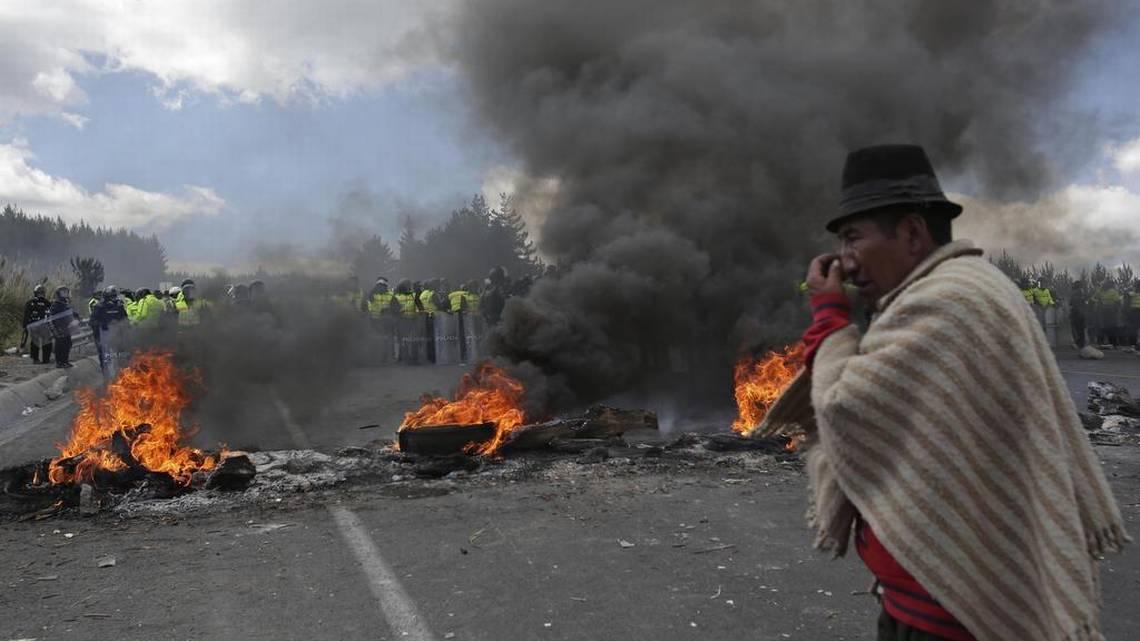
Ecuador’s powerful Indigenous movements once again took to the streets on June 13 to press the conservative government of President Guillermo Lasso to agree to their list of economic and social demands. The government’s repressive response has led to many injuries and arrests and several deaths, as the situation continues to grow more intense.
Lasso called for dialogue in the face of the strongest challenge to his one-year-old government, but opponents insist that they are not interested in negotiations but rather a change in policy.
Leading the charge is the Confederation of Indigenous Nationalities of Ecuador (CONAIE), an umbrella group of Indigenous organizations that activists founded in 1986.
The CONAIE, together with student groups and labor unions, put forward a list of 10 demands that include a freeze on fuel prices, a halt to the expansion of oil and mining exploration, a debt moratorium for small and medium-sized farmers, subsidies for agricultural producers, and guarantees that key sectors of the economy will not be privatized.
Activists launched an indefinite general strike that has included blocking roads across the country to press these demands.
On June 14, authorities arrested CONAIE’s president, Leonidas Iza, on charges of sabotage for having participated in blocking the Pan-American highway in the central highland province of Cotopaxi. A public outcry led to Iza’s prompt release, but also intensified and radicalized the protests.
Lasso had previously lashed out at Iza, branding him as an “enemy of democracy,” calling him “a violent man,” and accusing him of seeking to topple his government.
Scenes of a Police State
In an attempt to contain the mobilizations, Lasso declared a state of emergency beginning at midnight on June 17 in the three highland provinces of Cotopaxi, Imbabura, and Pichincha (which includes the capital city of Quito), where the initial protests were most intense. On June 20, Lasso extended the decree to six of Ecuador’s 24 provinces, even as activists defied the decree and continued their mobilizations.
A state of emergency is an executive decree, defined in the constitution, that enables the president to suspend the right to assembly and call out the military in times of disturbances or natural disasters. With the military out in force, the country began to acquire the image of a police state.
The sustained protests only appear to be growing. Tens of thousands of activists continue to march in both Quito and the commercial center of Guayaquil on the coast to press Lasso to agree to their demands.
Lasso responded with characteristically repressive actions, with more than one hundred arrested for their actions. Police fired tear gas, water cannons, and so-called nonlethal projectiles at the activists, injuring more than one hundred people, some of them seriously. At least three people have died so far in the demonstrations.
Byron Guatatoca, a Kichwa man in the Amazon town of Puyo, died after being hit in the face with a tear gas bomb at a roadblock.
On June 25, police raided the Casa de la Cultura in Quito. They allegedly were searching for “war material, such as explosives and handmade weapons.” The center and surrounding park space has often served as a base for thousands of militants and social organizations. When nothing was found, the police decided to use the center for their own base of operations.
The Casa de la Cultura is an autonomous cultural institution that was created in 1944. The only other time it has been similarly occupied was during the military dictatorship in 1963.
CONAIE: A Militant History
CONAIE is most well known for its organization of popular uprisings that have been known to include blockading of commercial arteries and the seizure and occupation of government buildings.
Beginning in the 1990s, grassroots activists repeatedly took to the streets in opposition to government policies that went against their interests. They successfully blocked some of the worst aspects of neoliberal economic policies and even pulled down governments that ruled against their interests.
In October 2019, as part of the estallido social or social outburst that spread across Latin America, activists in Ecuador against engaged in sustained protests against conservative president Lenín Moreno’s economic policies that benefited the wealthy at a cost to the poor and marginalized.
Moreno had attempted to remove longstanding fuel subsidies, as well as impose other dramatic austerity measures that would have a disproportionately negative impact on workers and Indigenous peoples.
A transportation strike on October 4, 2019 quickly spread to other sectors of society that were equally displeased with Moreno’s policies, with CONAIE and the United Workers’ Front (FUT) taking the lead. The government reacted to the protests with repressive measures, including arresting political opponents on dubious charges and sending others fleeing to embassies with requests for political asylum. After 11 days of large protests, Moreno finally backed down and abandoned his plans to eliminate the fuel subsidies.
These protests against regressive economic policies continued into Lasso’s administration. Street protests in October 2021 led the government to suspend a push to increase the price of fuel. In January 2022, CONAIE leaders once again organized protests over fuel prices, which have almost doubled in the past two years.
Indigenous peoples have been disproportionately affected by rising inflation rates, unemployment, and poverty. The coronavirus pandemic exacerbated all of these factors. The country is also being plagued with a rise in organized crime apparently related to drug trafficking that has led to deadly clashes in the prisons with massacres killing hundreds of inmates.